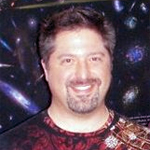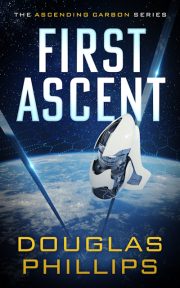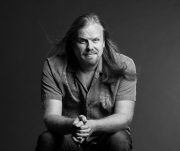Ten Classic Hard Science Fiction Novels featuring Physics and Astronomy
by Mike Brotherton
As a professor of astronomy, which is considered a “hard science,” I worry that the classification “Hard SF” is off-putting to many readers. It makes it sound like any story labeled as such will be hard to understand, which is not necessarily true. “Hard” is really just a term to refer to the fact that we can be quantitative about some scientific topics.
Hard SF entices me with the dramatization of alien worlds, exotic environments, and the strange-but-true things that exist in the universe. Worlds collide, stars explode, and black holes consume anything in their path. Scientists can write down the equations governing these extreme events, but it’s the SF writers who breathe life into such equations. Science reveals how cool the universe really is, but writers communicate it.
Here, then, are ten “Hard SF” novels that have stood the test of time. They showcase the wonder in what is possible in our own reality, they involve physics or astronomy in some way, and they represent excellent entry points for readers new to Hard SF. Some aspects of these stories may not have aged well, as science continues to make new discoveries that sometimes make older knowledge obsolete, but they all have fascinating core concepts and try to treat the universe and science realistically. In no particular order…
1. Mission of Gravity by Hal Clement. Hal Clement wrote many wonderful books investigating the extremes of alien worlds, and this one is arguably his most enduring. The rapidly spinning planet Mesklin has a high surface gravity mitigated near its equator by centrifugal force. Humans enlist the aid of centipede-like aliens for an expedition to the pole to recover lost equipment. I love the mutual exploration of a world simultaneously with the exploration of physics.
2. The Fountains of Paradise by Arthur C. Clarke. Inventor of the geosynchronous satellite, Clarke wrote a number of novels that could appear on this list. I love this one, which puts on display the idea of the space elevator (AKA “Beanstalk”). Rockets are inefficient, noisy, and expensive. Why not climb a bit more leisurely into space? There are myriad challenges to the idea, however, ranging from the technical to the political, and the very concept deserves the exploration that only fiction can provide.
3. Ringworld by Larry Niven. Instead of living on a planets orbiting a star, how about on the interior of a spinning ring? For the same mass you can have a lot more living space, as well as other benefits. The ringworld is one of the classic “big dumb objects” of SF and inspires outside-the-box thinking, which I admire greatly. When readers pointed out that the ring wasn’t stable, Niven had the excuse to write a sequel.
4. Dragon’s Egg by Robert Forward. Forward was a physicist and his books show it. This classic of hard SF takes Clement’s Mesklin orders of magnitude further and explores what life might be like on the surface of a neutron star.
5. Timescape by Gregory Benford, another physicist, puts the life of scientists in the spotlight. It is one of the first SF novels I read that seemed to get the reality of being a scientist. One point I really enjoyed was the realization that if you want to use tachyons to communicate with the past, you have to understand that everything is in motion and you have to aim your beam to where the Earth was in space.
6. The Black Cloud by Fred Hoyle. Hoyle was an astronomer and his tale of an interstellar molecular cloud enveloping the sun is a classic, steeped in the science of the time and clever speculation.
7. Tau Zero by Poul Anderson. Grand in vision, this story explores the limits of speed, space, and time. Relativity is often neglected in SF in favor of faster-than-light travel, but relativity still permits travel to anywhere in the universe in a human lifetime thanks to time dilation.
8. The Moon is a Harsh Mistress by Robert A. Heinlein taught me the importance of not being at the bottom of a deep gravity well in an interplanetary war. He pounded in that lesson very effectively, and when I recently read about private industry mobilizing to bring asteroids into Earth orbit to mine them, I shivered (see also Larry Niven and Jerry Pournelle’s Footfall, among others).
9. Contact by the astronomer Carl Sagan will always be a special book in my mind, enhanced by the 1997 movie. I grew up watching Cosmos on PBS, and it probably shaped my interest in becoming a scientist as much as Star Trek. The notion of finding circles in the digits of pi still haunts me.
10. The Forever War by Joe Haldeman is another special book. It takes the relativistic issues of Tau Zero, and melds them with the reality of war informed by the Vietnam experience, and was published at a time when SF was probably the best way to approach exploring a fresh wound. The novel has science, action, aliens, and a profound social commentary. It blew my mind in the most wonderful and challenging ways.
Yes, the list is composed of a lot of dead or graying male writers, but these days, when you include biological sciences, we have a lot more women (e.g. Nancy Kress, Catherine Asaro, Linda Nagata, Chris Moriarty, Brenda Cooper, Kay Kenyon, etc.) along with newer male writers (Alastair Reynolds, Greg Egan, Rob Sawyer, Kim Stanley Robinson, Paul McAuley, Peter Watts, Hannu Rajaniemi, Charles Stross, etc.). I’ve probably let a few folks slip through the cracks (Isaac Asimov, Greg Bear, David Brin, C.J. Cherryh, James P. Hogan, Charles Sheffield, Stephen Baxter, etc.), which is fine: a field this rich can’t be captured in a top ten list.
So check these out and make suggestions of your own. What are your favorites?
 Originally from the St. Louis area, Mike Brotherton got his PhD in astronomy from the University of Texas in 1996, and held positions at Lawrence Livermore National Laboratory and Kitt Peak National Observatory before coming to Laramie. His specialty is studying the supermassive black holes in the centers of galaxies and how they shine when in the active phase. He is also interested in the relationship between such active galactic nuclei (AGN) and their host galaxies, and their mutual evolution. His work is primarily observational, and he uses a wide assortment of telescopes/observatories operating across the electromagnetic spectrum including WIRO, McDonald, IRTF, KPNO, Lick, Keck, Gemini, the VLT, Hubble, Chandra, and the VLA. He also makes use of data archives such as the Sloan Digital Sky Survey. In addition to being a scientist, he is a science fiction writer, author of the well-received science fiction novels Star Dragon (2003) and Spider Star (2008) from Tor Books. He is also the founder of the NASA-funded Launch Pad Astronomy Workshop for Writers, which brings a dozen award-winning professional writers to Wyoming every summer. He blogs at www.mikebrotherton.com.
Originally from the St. Louis area, Mike Brotherton got his PhD in astronomy from the University of Texas in 1996, and held positions at Lawrence Livermore National Laboratory and Kitt Peak National Observatory before coming to Laramie. His specialty is studying the supermassive black holes in the centers of galaxies and how they shine when in the active phase. He is also interested in the relationship between such active galactic nuclei (AGN) and their host galaxies, and their mutual evolution. His work is primarily observational, and he uses a wide assortment of telescopes/observatories operating across the electromagnetic spectrum including WIRO, McDonald, IRTF, KPNO, Lick, Keck, Gemini, the VLT, Hubble, Chandra, and the VLA. He also makes use of data archives such as the Sloan Digital Sky Survey. In addition to being a scientist, he is a science fiction writer, author of the well-received science fiction novels Star Dragon (2003) and Spider Star (2008) from Tor Books. He is also the founder of the NASA-funded Launch Pad Astronomy Workshop for Writers, which brings a dozen award-winning professional writers to Wyoming every summer. He blogs at www.mikebrotherton.com.



